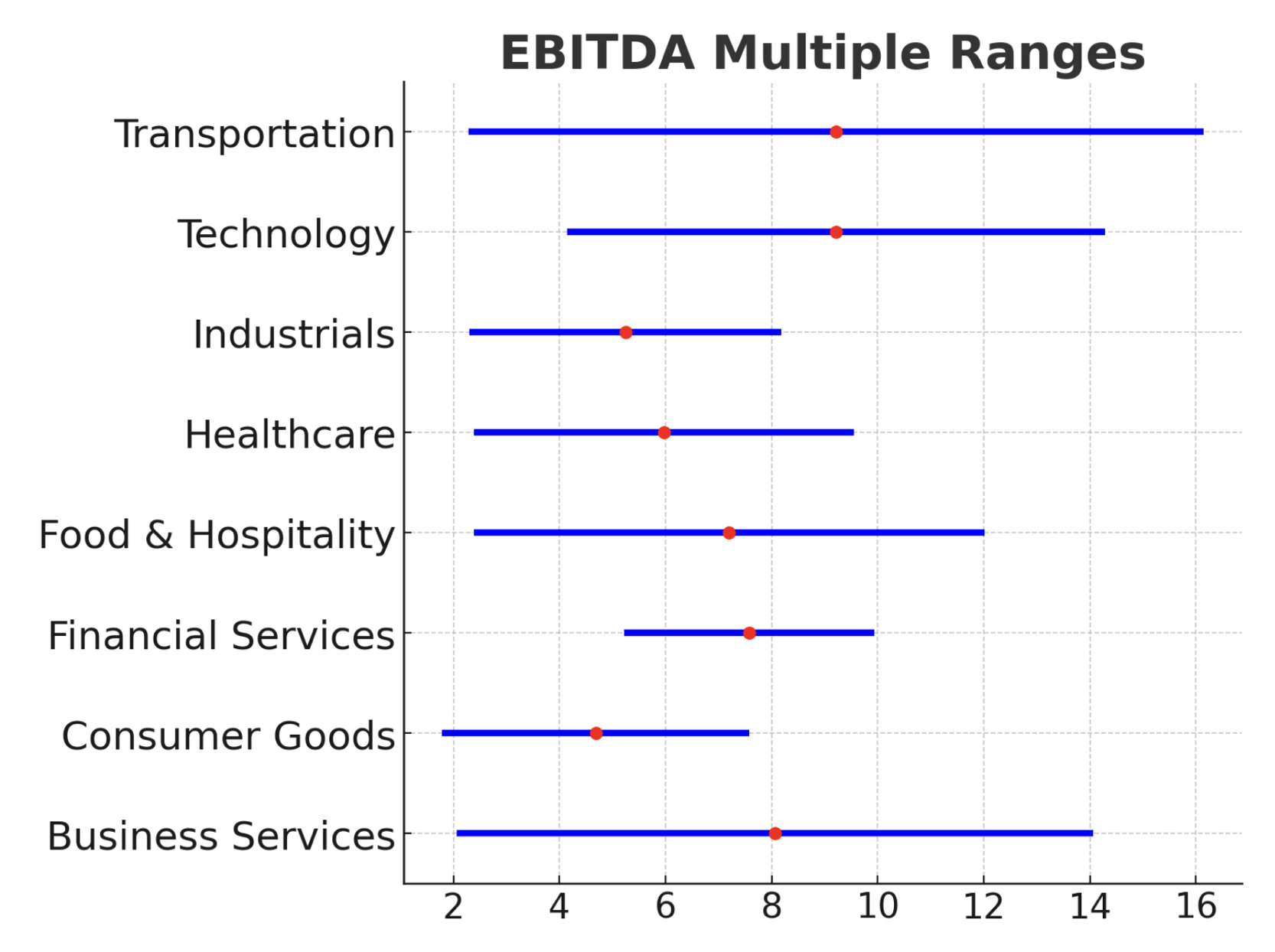
The Advisor Finder Report: Q3 2025
Welcome to the Q3 2025 issue of The Advisor Finder Report, a quarterly publication that surfaces the activity occurring on…
Understanding how prospective buyers determine your business’s value is a key factor in a successful sale. Their starting point for any valuation is your EBITDA and EBITDA multiple, so a strong grasp of what these metrics are and how they’re used puts you in a good position to strike the right deal.
Let’s start by defining the terms:
Many business owners start by searching online to find their business’s EBITDA multiple, often looking up average EBITDA multiples by industry, but these numbers aren’t helpful in finding the actual value of your business. EBITDA multiples are not fixed; there’s a wide range within each sector. The multiple range can shift because of changes in the industry. However, there are specific things you can do as a business owner to increase your EBITDA multiple and the value of your business.
To get a true picture of EBITDA multiples across industries, this post explores:
Axial matches business owners with the right M&A advisor to secure the best business exit, from valuing your business to handling negotiations and closing the deal. With over 2,000 vetted advisors and 14 years of insights into the deals they’ve closed, our Exit Consultants connect business owners with 3–5 advisors who are best positioned to identify the right buyers and negotiate the terms of your business sale.
When you’re ready to find the right M&A advisor for your business, you can learn more about Axial’s services and request a consultation.
A business’s EBITDA is important for all stakeholders involved in the M&A process:
Business owners occasionally try to calculate the worth of their company using EBITDA on their own. However, this is a difficult calculation, and errors can be catastrophic for your business exit:
EBITDA calculations are complex and nuanced, relying on complete, reliable financial records. Below, we show how much EBITDA multiples can vary, even within a single industry, based on individual businesses.
The data on EBITDA multiples we’re about to present comes from Axial’s Winning LOI Hub — a selection of 100 Letters of Intents executed between business owners and buyers through the Axial network. The Winning LOI Hub is updated quarterly, and you can search the data we surface by industry and buyer type to see the offers made on real businesses within the market.
Note: The multiples below are for small to mid-sized businesses. Additionally, many unique factors have influenced the EBITDA multiples in the table. They should be used as an overview of your industry, not as a guarantee of the EBITDA multiple you can expect for your business.

Range of EBITDA multiples: 2.2–16.2, with a median of approximately 9x EBITDA
The EBITDA multiples for businesses in the transportation sector vary significantly. This is because we see a wide range of business types and deal sizes in the transportation sector.
For example, the Winning LOI hub shows:
Transportation businesses can be divided into distinct camps in terms of the risk an investment poses to a new owner.
On the one hand, some businesses have strong recurring revenue, low capital expenditure, and high operational efficiency. These businesses are attractive because they promise stable cash flow and low reinvestment for the buyer. Some businesses may achieve an extremely high EBITDA multiple if their service is also strongly differentiated or the company has strategic dominance.
On the other hand, transportation can also be a very volatile sector. Take the trucking industry, which is heavily impacted by fuel prices and regulatory pressures. Some businesses are also dependent on cyclical demand, or they have heavy asset requirements that need a high level of ongoing investment. The EBITDA multiple for these businesses tends to be much lower.
Range of EBITDA multiples: 4.1–14.3, with a median of approximately 9x EBITDA
Like transportation, technology businesses can have a range of EBITDA multiples. Technology businesses with a unique service or intellectual property command a higher multiple, while businesses that need more ongoing investment or have more competitive threats command less.
While the success of some tech products skyrockets, plenty of others don’t catch on. One sector that can often demand a higher multiple is the SaaS sector, especially those with subscription based models as this shows recurring revenue.
We’ve also noticed a recent shift toward technology buyers prioritizing profitability over pure growth, which has affected the EBITDA multiples of tech companies in recent years.
More buyers are seeking sustainable, cash-flow positive businesses that offer a more certain investment. This means companies with consistent profitability can achieve higher EBITDA multiples (and generate more buyer interest), even if their growth is slower. In contrast, unprofitable companies can have lower multiples, even with high growth.
Range of EBITDA multiples: 2.3–8.2, with a median of approximately 5x EBITDA
Companies in the industrials sector are the backbone of the economy. Regardless of economic conditions, many businesses in this industry — from plumbing and electrical services to waste collection — will remain in demand.
That said, the EBITDA multiples for the industrials sector tend to be lower. It’s also important to note that although one business in this sector received an offer for 8.2x their EBITDA, it was more common to see multiples of 3, 4, or 5.
While buyers may be confident in the demand for industrials businesses’ products or services, they also know that growth will require significant investment in the company’s infrastructure (e.g., custom machining to serve clients).
Higher EBITDA multiples typically come from industrial companies with evidence of recurring revenue. If an HVAC company has a catalog of long-term maintenance contracts and strong diversification, for example, it’s seen as a lower risk and commands a higher multiple. On the other hand, businesses that depend heavily on project based work, or a small number of clients are less predictable and may receive lower offers from potential buyers.
Range of EBITDA multiples: 2.4–9.7, with a median of approximately 6x EBITDA
The healthcare industry is incredibly diverse. In some areas, EBITDA multiples are influenced by the same factors that affect the tech sector. For example, a med tech business with a new patent can be very attractive, but much less so if the patent is about to expire, opening the market to generic versions. Additionally, businesses like these often require significant investment in research and development, which can lower the EBITDA multiple to reflect the buyer’s costs.
Healthcare also includes medical practices and care providers. For these businesses, providers with recurring revenue and high patient retention tend to command a higher multiple. Physical therapy and home healthcare, for example, tend to be attractive, as do other medical practices that can show consistent cash flow and low operational risk.
On the other hand, some healthcare businesses can be less interesting to buyers. Elective surgery centers where patients come for one-time procedures, for example, might have a more unpredictable cash flow. Practices that provide niche services with high reimbursement challenges (for example, through Medicare and Medicaid) might also receive lower multiples.
Range of EBITDA multiples: 2.4–12, with a median of approximately 7x EBITDA
The range of multiples in the food and hospitality industry is one of the widest we see. This is due to the industry’s vulnerability to price fluctuations and economic downturns, though different subsections respond in varying ways.
For example, during an economic downturn, some food and beverage companies may benefit as higher-end consumers switch from dining out to shopping at upscale grocery stores. Discount grocery stores may also see a boost as consumers look to save money by changing where they shop.
Generally speaking, companies that command higher multiples in this industry have:
In food and hospitality, location plays a much more significant role in valuation compared to other sectors. It directly impacts the company’s visibility and customer base. Restaurants and catering businesses with multiple locations can also have more diverse and reliable streams than those that rely on a single location or seasonal traffic.
Range of EBITDA multiples: 1.78–7.6, with a median of approximately 5x EBITDA
Generally speaking, firms with higher multiples tend to fall into sub-sectors like wealth management and financial advice. These companies tend to have steady, recurring revenue streams through long-standing relationships with their clients, which means they can show potential buyers evidence of reliable cash flows.
On the other hand, transactional financial services companies — like mortgage brokers or insurers — often experience variability in their revenue and a higher client turnover. The EBITDA multiple can also be lowered significantly for firms that have become dependent on key personnel, or that can’t show evidence of a strong regulatory compliance process and infrastructure.
Range of EBITDA multiples: 2–14, with a median of approximately 5x EBITDA
Like food and hospitality, the consumer goods industry can be very sensitive to economic downturns. While consumers will always need to replace appliances, for example, demand for premium products is usually reduced when more consumers are trying to rein in their household spending.
For a business in this sector to command a consistently high multiple, buyers want to see:
These companies are less impacted by economic downturns so they can realize a more stable return for investors. In contrast, luxury businesses tend to experience a sharper drop in demand during a recession, which can drive multiples down as buyers become more cautious. While some businesses offering premium products or high-cost, one-time purchases can still be attractive, generally speaking, EBITDA multiples for businesses with a diverse range of essential products will be higher.
Range of EBITDA multiples: 2–14 with a median of approximately 8x EBITDA
The business services industry includes firms that support other companies. They don’t focus on physical products, but services that help businesses run more productively and efficiently. For example, consultants, legal services, IT firms, marketers, and accountants all fall into this category.
Business services can expect a higher EBITDA multiple if their offering is essential or they have recurring contracts. Low churn and a business model based on either a subscription service or multiple long-term contracts can be attractive to buyers. This is because, while businesses may cut costs during a recession, they’ll likely retain services that are critical to keeping their operations afloat.
On the other hand, project-based or discretionary businesses command lower multiples in this sector. Consulting firms, for example, may struggle to show evidence of recurring revenue from one client, and marketing companies often have shorter relationships with their clients. Additionally, when businesses need to cut expenses, they typically reduce discretionary services first. When revenue and demand fluctuate due to economic conditions, it can significantly lower the investment appeal of these businesses.
The figures we’ve discussed here can provide an indication of the valuation ranges you might see for your business. However, a more detailed analysis is necessary to get an accurate picture of your valuation as you consider selling.
Alongside the market dynamics discussed for each industry, there are many factors unique to your business that will influence your EBITDA multiple. Some, like industry regulations, are beyond your control. However, there are areas where business owners have more power.
While you can’t change the overall market perception for an entire sector, you can make your business more attractive within the context of your industry, thereby increasing your multiple and the value of your business.
Bear these factors in mind — and do what you can to optimize them — as you plan your exit:
There are opportunities — and even some potential “quick wins” — to improve your EBITDA multiple and your business valuation in the lead-up to your exit. But, as every business and every exit plan is unique, the best way to prioritize the opportunities, optimize your business, and ultimately improve its value is to work with an M&A advisor.
Calculating an accurate valuation is a complicated process with several factors to consider, both internal (like how your business is set up) and external (such as market sentiment and buyer demand).
It’s nearly impossible, as a business owner, to arrive at a reasonable valuation range on your own. That’s why we recommend partnering up with an M&A advisor who has experience in company valuation.
M&A advisors are experts at understanding the factors that influence EBITDA multiples and balancing these considerations to drive a successful sale. The best way to get an accurate valuation (and a smooth business sale) is to work with an advisor.
An M&A advisor will:
You can also use our free business valuation calculator to get an idea what your business is worth. Our calculator uses an industry-specific DCF method that’s preferred by leading M&A advisors.
The best way to value your business, attract qualified buyers, and close a deal with attractive terms is to work with an advisor, and the best way to find an advisor who’s a good fit is through Axial.
Business owners begin the process by meeting with one of Axial’s trusted Exit Consultants. They take time to learn about your business and exit goals, then hand-pick a list of 3–5 potential advisors from our network of over 2,000+ vetted M&A professionals.
Your Exit Consultant will guide you through the list, sharing insights into each advisor’s industry experience, past deals, and professionalism. Once you have a shortlist, your Exit Consultant will assist in interviewing the candidates and making your final decision.
When you work with a trusted M&A advisor, you can benefit from:
To get started, you can request a free consultation with Axial today.
